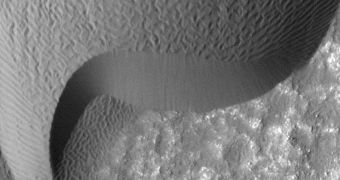New data sent back by the NASA Mars Reconnaissance Orbiter (MRO) spacecraft indicate that Martian sand dunes are constantly shifting their positions, most likely under the influence of strong winds and a restless atmosphere.
This phenomenon is not isolated, researchers say, since instances of it occurring have been spotted at dozens of locations around the planet. This implies that the landscape is changing at a constant pace, depending on the weather.
Such studies were made possible by the extremely sensitive imaging instruments aboard the MRO, which include the High Resolution Imaging Science Experiment (HiRISE) camera. The instruments revealed that dunes can shift up to a few yards during short intervals.
This discovery does not really surprise scientists, since storms and dust devils are common occurrences, which have been heavily documented by a number of NASA assets. These include the Mars Exploration Rover (MER) Spirit, which imaged a few dust devils at different locations.
These atmospheric events were known to swirl up the reddish, fine dust on the planet's surface, but scientists were until now unsure whether the same held rue for the heavier sand grains Martian dunes are made of. The answer appears to be yes.
“Mars either has more gusts of wind than we knew about before, or the winds are capable of transporting more sand,” researcher and planetary scientist Nathan Bridges explains. He is based at the Johns Hopkins University (JHU) Applied Physics Laboratory (APL), in Laurel, Maryland.
“We used to think of the sand on Mars as relatively immobile, so these new observations are changing our whole perspective,” he adds. Bridges is also the lead author of a new study detailing the MRO observations. The work appears in the latest online issue of the esteemed scientific journal Geology.
Thanks to HiRISE observations, experts now know that dunes move up to a few years per year, and also that the trend is spread all over the planet. Since arriving in Martian orbit – back in 2006 – MRO has been constantly surveying these dunes.
“The sand dunes where we didn't see movement today could have larger grains, or perhaps their surface layers are cemented together. These studies show the benefit of long-term monitoring at high resolution,” Bridges adds.
MRO will continue to keep an eye on Martian dunes throughout its extended mission. The spacecraft has thus far sent massive volumes of data back to Earth. NASA says that the orbiter has provided the largest amount of electronic data off any of its probes.

 14 DAY TRIAL //
14 DAY TRIAL //